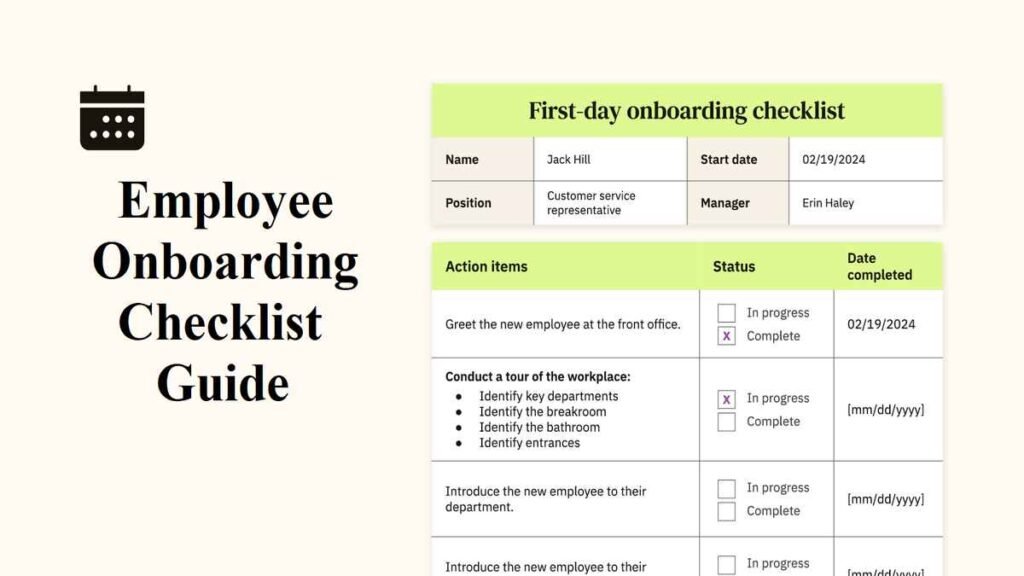Employee Onboarding Checklist Guide, as it a critical step in ensuring new hires are well-integrated, productive, and confident in their roles. A successful onboarding process goes beyond filling out forms—it involves orientation, training, and helping employees understand the company’s culture. This guide will walk you through the essentials of an effective employee onboarding checklist, ensuring a smooth transition for your new team members.
Bringing a new employee on board isn’t just about paperwork; it’s about welcoming them into your organization and setting them up for success. The onboarding process helps employees feel comfortable, informed, and equipped to contribute meaningfully to their team. In this guide, we’ll provide a comprehensive checklist to streamline the process and ensure you don’t miss any important steps.
Understanding the Employee Onboarding Process Guide
What is Employee Onboarding?
It involves everything from paperwork and compliance to training and cultural assimilation. A well-structured onboarding process not only boosts productivity but also enhances employee retention.
Why is an Onboarding Checklist Important?
An onboarding checklist ensures that the process is organized, thorough, and consistent. With a checklist in hand, HR teams can streamline the onboarding experience and ensure new hires have all the resources they need from day one.
Follow Us: Trady Zone
The Importance of an Employee Onboarding Checklist
Structured Onboarding vs. Unstructured Onboarding
A structured onboarding process ensures that new employees receive a comprehensive introduction to their role and the company. In contrast, an unstructured process can leave employees feeling lost and unsupported, which may affect their performance and job satisfaction.
Benefits of Using an Employee Onboarding Checklist Guide
- Ensures all necessary tasks are completed
- Helps employees feel welcomed and supported
- Reduces the risk of missed paperwork or incomplete training
- Encourages a positive first impression of the company
New Hire Orientation Checklist
Pre-Arrival Preparation
The onboarding process starts even before the new hire steps into the office. Here’s how to prepare:
- Send a Welcome Email: Let the new hire know what to expect on their first day, including parking, dress code, and key contacts.
- Prepare the Workstation: Make sure their desk, computer, and necessary tools are ready.
- Share Company Policies and Documents: Provide access to handbooks, policies, and other important documents before the first day.
Day 1 Orientation
The first day sets the tone for the rest of the employee’s experience. A successful orientation includes:
- Office Tour: Familiarize the new hire with the office layout, restrooms, kitchen, and emergency exits.
- Introductions: Introduce the new hire to their team and key company leaders.
- Setting Up Technology: Ensure their email, software, and communication tools are ready to go.
- Overview of Job Expectations: Discuss their job role, goals, and key responsibilities.
Employee Training Plan
A training plan is essential for helping new hires gain the skills and knowledge needed to succeed in their role.
Designing a Training Program for New Employees
Training should cover both job-specific skills and broader knowledge about the company’s mission and values. Consider a mix of in-person training, online modules, and self-guided learning.
Monitoring Progress and Providing Feedback
Regularly check in with new hires to assess their progress and offer constructive feedback. This helps ensure they are meeting expectations and feeling confident in their role.
Role-Specific Training: Employee Onboarding Checklist Guide
Tailor training to the individual’s role. For example, a new sales employee might need different training than a new IT technician. Cross-training between departments can also be beneficial for broader understanding.
Workplace Integration Strategies
Facilitating Social Connections
Building relationships with colleagues is key to workplace integration. Encourage new hires to participate in team lunches, social events, and informal meet-and-greets.
Mentorship Programs
Pairing new hires with a mentor can provide valuable guidance and support during the onboarding process. Mentors can help answer questions, offer advice, and make the new employee feel more connected to the team.
Employee Engagement in the Early Days
Engaging employees early on helps to foster loyalty and satisfaction. Plan for regular check-ins, provide opportunities for feedback, and encourage participation in company initiatives.
Onboarding Process Steps for HR
Pre-Onboarding Steps for HR: Employee Onboarding Checklist Guide
Before the new hire arrives, HR should ensure that all necessary documents, contracts, and benefits information are prepared. It’s also essential to communicate the onboarding timeline to the employee.
First Week and First Month Milestones
Set clear goals for the first week and month, such as completing training modules or shadowing a senior team member. This gives the new hire a sense of direction and accomplishment.
Post-Onboarding Follow-Up
After the formal onboarding process is complete, gather feedback from the new employee about their experience. This feedback can help improve the onboarding process for future hires.
Conclusion
A well-executed onboarding checklist ensures that new hires are equipped with the knowledge, skills, and confidence they need to succeed. By following a structured onboarding plan, companies can improve employee retention, satisfaction, and productivity.
FAQs
What is included in an Employee Onboarding Checklist Guide checklist?
An onboarding checklist typically includes pre-arrival tasks, orientation steps, training programs, and workplace integration activities.
How long should the onboarding process take?
While the formal onboarding process usually lasts a week or two, full integration can take several months.
What is the difference between orientation and onboarding?
Orientation is a short-term event that introduces employees to the company, while onboarding is a long-term process that helps them adjust to their new role.
How do you measure onboarding success?
Onboarding success can be measured through employee feedback, performance evaluations, and retention rates.
What tools can help with onboarding?
Tools like HR software, learning management systems, and project management platforms can streamline the onboarding process.
Read More: Penetration Testing Service Provider


